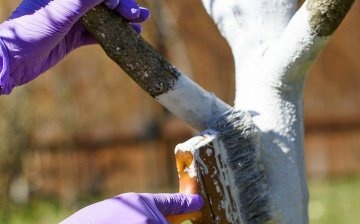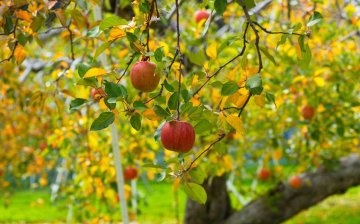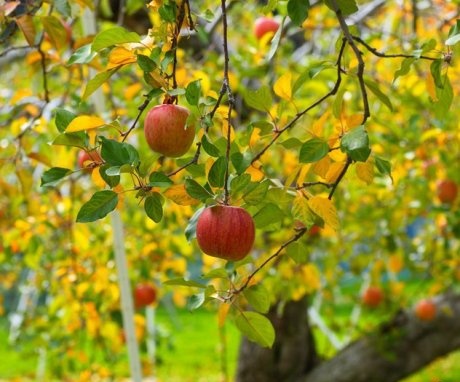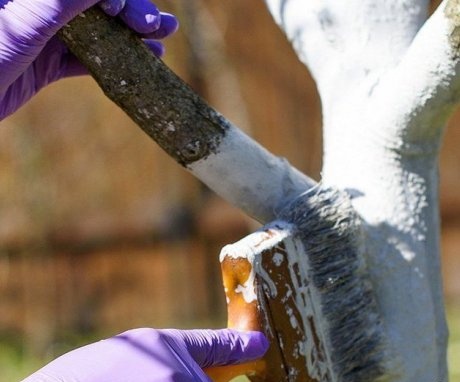How and when to properly carry out the autumn processing of fruit trees
An experienced gardener knows that every season needs to be done some important work in the garden. As for spring, everything is clear here - the garden is awakening from hibernation and requires some care. However, there are many important things to do for the fall, in particular, you need to carry out a kind of general cleaning in the garden. The harvest of the next year will largely depend on how to prepare the garden for winter sleep and how the autumn processing of fruit trees will take place.
Why process a tree in the fall
In the summer, many pests accumulate under the bark of fruit trees. Of course, gardeners always take care of their garden and poison unnecessary insects as soon as they spread.
However, in the fall this is the most difficult thing to do: on the leaves, traces of their vital activity can no longer be found, because the foliage flies around at this time of the year. The difficulty in finding insects is that they hide for wintering. To do this, they climb into the cracks located on the bark, hollows, burrow into the soil of the trunk circle and other shelters.
Having sheltered, thus, the pests will successfully overwinter and, with the onset of spring, will give birth to offspring. Then all this large army will begin to parasitize on the tree, eating leaves and fruits and spoiling the bark. In order to prevent this and much more, trees are processed in autumn.
Purposes of processing
If you look closely, in fact, there are several goals that are pursued by carrying out the autumn processing of fruit trees before the onset of cold weather. These include:
- Preparing trees for hibernation.
- Destruction of pests hiding for the winter.
- Fight against rot and fungi, which will also develop with the onset of heat.
- Removing the tree from mosses, lichens, unnecessary growths and old branches.
Preparatory stage
In order for the autumn processing of the garden to be effective, it is necessary first of all to perform the following work.
Harvesting leaves
To do this, use a rake to remove all leaves that have fallen to the ground. If in the past season the presence of pests and diseases was not observed on fruit trees, it means that the foliage is quite healthy and can be used for composting in a special heap, for arranging warm beds or as mulch for perennial wintering flowers. It is important to remove from the site or burn all fallen leaves if it is affected by powdery mildew, scab or other diseases - such leaves are not only unsuitable for use, but also dangerous for trees.
Abundant watering
Fruit trees should not be allowed to remain with overdried soil before a long winter. When it was dry autumn, you need to thoroughly shed the trunk circle near each fruit tree with plenty of water. To do this, about 50 liters of water should go to one adult tree.
Such irrigation is called water-charging. This does not mean that you immediately need to pour the entire required volume under the root. This will be of little use, because the water will spread far beyond the limits of the near-trunk circle and will not be absorbed quite where it is needed. It is necessary to water the tree in stages: 12-15 liters are poured out in one hour. With this method of irrigation, the soil is well saturated to a depth of about 1m.
It is not recommended to pour ice water from the tap.It should be about 5 degrees warmer than the air temperature. After all these manipulations, the trunk circles are mulched. The most suitable material is spruce branches (it will protect from rodents), peat, humus or compost. Thus, you can be sure that moisture will remain in the ground.
Preparation of fruit bushes
Just like trees, fruit bushes also need autumn preparation. All unnecessary branches are removed from them - this way young shoots will begin to grow faster in spring. For the best wintering, the bushes are fertilized with potassium-phosphate fertilizers (1 tablespoon for each bush).
Raspberries are cut at the root: all fertile bushes affected by diseases, or those that create a strong thickening of the plantings, are subject to removal. Organic matter is introduced under the remaining raspberry bushes: manure (6 kg per 1 sq. M) or chicken droppings (with water 1:12).
Pest control
In the second half of October, and if it is a dry warm autumn - at the beginning of November, you can take up the autumn processing of the garden from pests. It is carried out if there have already been the first frosts. High-quality spraying will be greatly facilitated by the fact that there is no longer any foliage on the trees.
The procedure requires a calm, dry day. Of course, a person must take care of personal protective equipment. Most spray preparations are toxic.
Processing time
In all regions, the timing may be different, because the climate cannot be the same everywhere. You need to focus on when the leaves fall. However, not everything is so simple here, because all trees shed their foliage at different times. Apple tree, for example, it can keep it at all until the onset of severe frosts. Therefore, experienced gardeners recommend carrying out this procedure towards the end of October. Before spraying, you should check the weather forecast and make sure that there will be no rain for at least two days after the procedure.
How to spray and how to do it right
There are many means with which it is recommended to spray fruit trees against diseases and pests. Each gardener knows the peculiarities of his garden, so he can assess where he is most likely to expect a threat from. It means that each drug has its own directional effect; not a single agent will immediately protect against all threats. Therefore, drugs are selected based on the type of prevailing pests.
Urea
Urea or carbamide is a granular fertilizer popular with gardeners, which contains a large amount of nitrogen (46%). This fertilizer is odorless and water soluble. Urea helps to fight both pests and pathogens of fruit trees.
You need to be careful with urea, too much concentration can cause poisoning and burn the plant. Spraying with urea is recommended to complete the preparation of the garden for winter.
Of course, an aqueous solution is being prepared for this, but the concentration for autumn processing must be high. This is the only way to destroy all pests trying to hide for the winter and their larvae. For 10 liters of water (bucket) of water, take 0.5 kg of urea (5% solution) and stir until it is completely dissolved.
Young seedlings, after they have dropped all the foliage, are treated with an even more concentrated solution - 535 g of urea per bucket of water (this is a 7% solution). Both the branches and the trunk of plants are subject to careful processing. This processing is useful. After all, this is not only the dressing of pests, but also a winter fertilization.
inkstone
It is an inorganic substance, ferrous sulfate. In appearance, these are small turquoise crystals. In the garden, it is used as a universal antiseptic.
He copes with mosses and lichens, which often grow on the surface of the bark. In the fall, such processing is important. External processing with this tool goes in conjunction with feeding it.
Thus, the plant is not only freed from pests and diseases, but also supplied with such an important component as iron. Without iron, the tree's yield drops dramatically.
In addition, ferrous sulfate normalizes soil acidity. Under the influence of iron vitriol, tree diseases such as lichen, scab, black cancer, cytosporosis, moss and all kinds of parasites are destroyed. To prepare the solution, take 1 kg of dry matter per 16 liters of water.
Copper sulfate
Copper sulfate is a powerful antifungal agent known to all gardeners for treating plants, which at the same time can enrich it with iron ions.
Treatment with this substance is extremely important. This product contains high concentration of fungicides, fires prevent the development of scab, powdery mildew, rot. It is required to process pears, apple trees and plums - for these crops, such a procedure is required. It is recommended to spray other fruit trees and shrubs, but not necessarily.
When the trees in the garden are still young and their age has not exceeded 6 years, then 2 liters of copper sulfate solution are consumed per plant. Over the years, the amount of the product increases, and on very old trees it takes up to 10 liters of solution.
Processing is required twice a day at a temperature of at least +5 degrees. It is also required to select the day for spraying so that there is no wind, otherwise the sprayed preparation can simply be carried away in the other direction.
Bordeaux mixture
It is a mixture of copper sulfate powder and calcium hydroxide (lime mixture). Copper compounds protect against pests, mold and fungi, and the lime mixture neutralizes all the harmful properties of copper sulfate.
The solution is always prepared immediately before use (its shelf life should not exceed 10 hours). For this, all components are diluted in the required proportions. First of all, 150 g of the lime mixture is thoroughly mixed in a small amount of water, then all this is poured into 5 liters of clean water and stirred again.
100 g of copper sulfate is diluted, on the contrary, in hot water, until it is completely dissolved, it is also poured into 5 liters of water. Then these two components are combined, and 10 liters of 1% Bordeaux liquid are obtained.
Insecticide treatment
Since it is strictly forbidden to treat the garden with insecticides during the flowering period, the same treatments are recommended in the autumn. Fugicides (remedies for diseases and fungi) and insecticides (remedies for insects) are chemical preparations that are used in the garden both for the treatment and prevention of diseases and harmful activities of insect pests.
The nuances of autumn processing
- Trees are sprayed with a manual or mechanized apparatus. Such a device not only allows you to evenly distribute the agent, dispense it, but also protects a person from direct contact with a toxic drug. It is better to spray low-growing plants directly from the ground, higher ones - from a stepladder.
- Previously, all cracks in the tree are sealed with garden varnish or a mixture of 100 rosin, 200 g of beeswax and 100 g of melted fat.
- The soil around the trunk is dug 15-20 cm, loosened, fertilized and mulched.
- Before processing, all remaining fruits are removed from the branches.
- If it rains after spraying, you will have to do everything again.
- Autumn spraying is carried out with more concentrated solutions than in spring. This applies to any of the above means.
Processing of bushes of grapes
If fruit trees, in addition to young seedlings, winter on their own, then the grapes need to be covered. After all the foliage has fallen from the vine, it must be cut off and treated with copper sulfate (3%). Then you need to build a shelter for him from spruce branches, reeds or other material. It is believed that mice quickly start up in shelters made of straw, they arrange nests there for wintering.
What else needs to be done
Other mandatory autumn procedures.
Whitewash
Whitewashing tree trunks in winter is necessary in order to protect them from both pests and autumn sunburn. The trunks are whitewashed to a height of about 1m, almost to the very skeletal branches. It is recommended to buy a ready-made garden whitewash in the store - such compositions are inexpensive and easy to use, because they can be applied immediately to the tree.
It is recommended to prepare the whitewash composition yourself. You need to take 3 kg of lime and 0.5 kg of copper sulfate for 10 liters of water. All this is well mixed and thickly applied to the tree trunk. Dates of autumn whitewashing of trees - late October to early November.
Top dressing
Feeding fruit trees before wintering is the right decision. This helps them to overwinter, because the roots will always receive useful substances. This is important during a harsh season like winter.
For autumn feeding, slurry (diluted with water in a ratio of (1:10), compost (1.5-3 kg per 1 square meter per area around the trunk), or humus (0.5 buckets per 1 square meter of the trunk circle).
In the fall, any fertilizers are applied to the soil near fruit trees, only nitrogen is not required. This is due to the fact that nitrogen stimulates growth processes and the plant's winter hardiness is greatly reduced because of this. Of the microelements, phosphate-potassium fertilizers are best suited during this period. For example, for relatively young plants up to 10 years old, you need to add 2 tbsp. superphosphate and 1 tbsp. potassium chloride per 1 sq.m. a hollow circle.
For cherries and plums, 3 tablespoons of superphosphate together with 2 tablespoons are suitable. potassium sulfate. Any fertilizer before application to the soil is diluted in 1 bucket of water (all norms are indicated for this amount of liquid). It is important for a beginner gardener to remember: for older trees, double the dosage of any fertilizer. Each tree will require 4 servings of fertilizer, i.e. 4 buckets.
Pruning fruit trees in autumn
In order to cut dry branches from trees before the onset of cold weather, you must choose a fine, windless day. You will need a sharply sharpened pruner or saw, so as not to injure the branches once again and so that the cuts are as even as possible. All dry, diseased and damaged branches are subject to removal.
There is no need to regret, there will be no more fruit on them, and for a tree such branches will be an additional burden. You should also remove those branches that grow incorrectly - inside the crown.
All cuts and cuts must be treated with a solution of copper sulfate (for 1 liter of water - 1 tsp of powder), and top with garden varnish (oil paint is also suitable). If these places are not treated, then various small pests can penetrate through these places.
Frost protection
All garden work must be completed before the temperature drops to 0-5 degrees. Young apple trees are sheltered in burlap for the winter, older ones better tolerate the cold, so whitewashing the trunk is enough - this technique also protects from frost. Grape cover well with roofing material.
For protection from cold weather, it is customary to use coniferous spruce branches (it not only retains heat, but also protects against rodents), sawdust, peat. It is strictly forbidden to compact the sawdust layer. If this is done, oxygen will cease to flow to the root, it may die off.
Snow that accumulates in the garden does not need to be thrown off the site; it will be able to cover the space around trees and shrubs.
Watch a video about the autumn processing of fruit trees:















The fact that the trees are whitened is a fact, but few people carry out the treatment with chemicals. Someone thinks that there is no need to be stuffed with chemistry, someone simply does not know that it needs to be done. We always whitewash the trees.
In the fall, we always remove the leaves in the garden, whitewash the trees, but we have never done watering, feeding and processing from pests and diseases. This year we will try to do everything right.